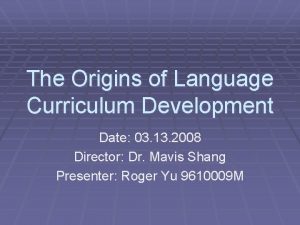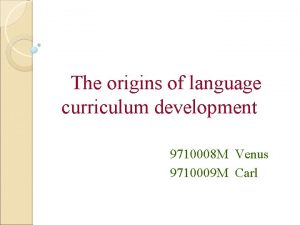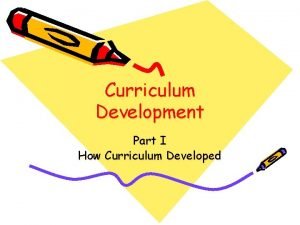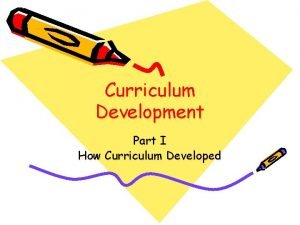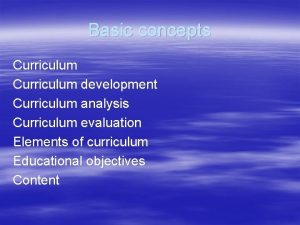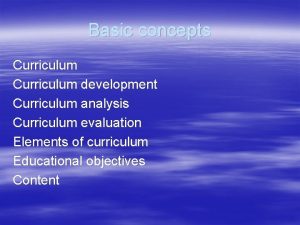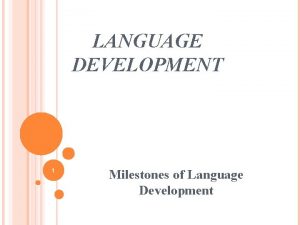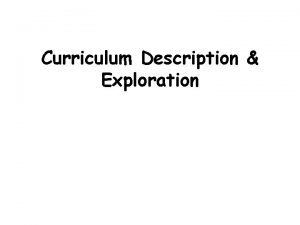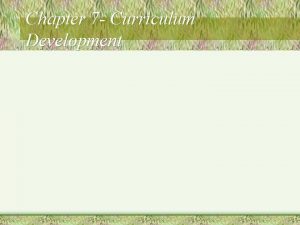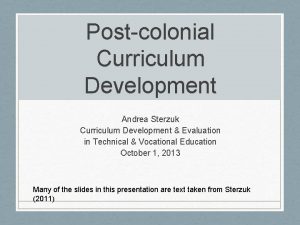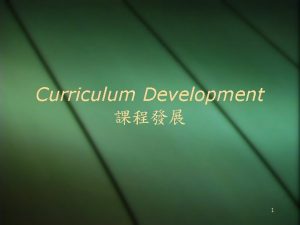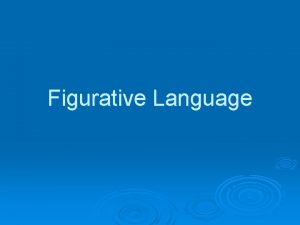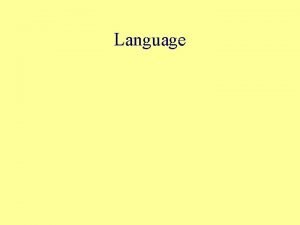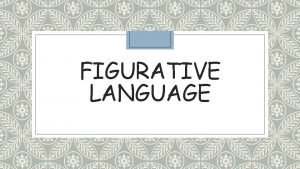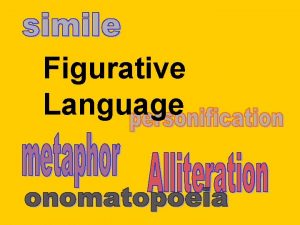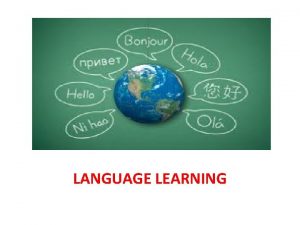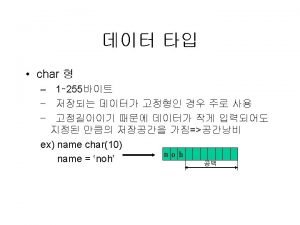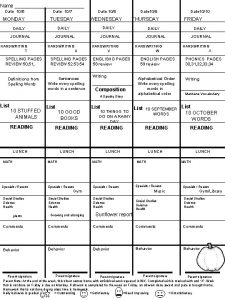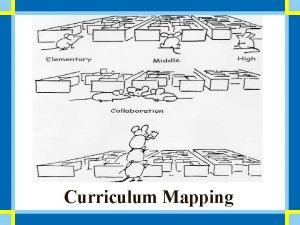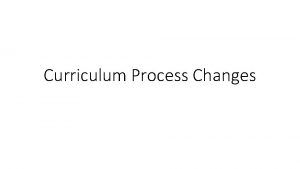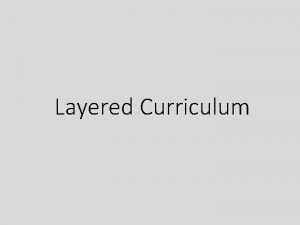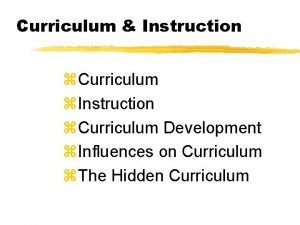The Origins of Language Curriculum Development Date 03






























- Slides: 30

The Origins of Language Curriculum Development Date: 03. 13. 2008 Director: Dr. Mavis Shang Presenter: Roger Yu 9610009 M

Introduction § Curriculum development focus on determining ØWhat knowledge, skills, and values students learn in schools. ØWhat experience should be provided to bring about intended learning outcomes. ØHow teaching and learning in schools or educational systems can be planned, measure, and evaluated.

Introduction § Language curriculum development focus on ØDesigning language programs. ØRevising language programs. ØImplementing language programs. ØEvaluating language programs. § This book focus on providing the tools ØSurveying approaches to language curriculum development. ØExamining language programs and language teaching materials.

Introduction § 9 Questions lead the framework of this book ØWhat procedures can be used to determine the content of a language program? ØWhat are learners’ need? ØHow can learners’ needs be determined? ØWhat contextual factor need to be considered in planning a language program? ØWhat is the nature of aim and objectives in teaching and how can these be developed?

Introduction § 9 Questions lead the framework of this book ØWhat factors are involved in planning the syllabus and the units of organization in a course? ØHow can good teaching be provided in a program? ØWhat issues are involved in selecting, adapting, and designing instructional materials? ØHow can on measure the effectiveness of a language program?

Historical Background § Language curriculum development ØStarts with the notion of syllabus design. ØA major factor in language teaching ØContent of a course ØReally begin in 1960 s. ØThe key of stimulus is teaching methods’ change—for better methods.

Historical Background § Language curriculum development includes more issues than syllabus design ØThe needs of learners ØObjectives for a program ØAppropriate syllabus, course structure, teaching methods, and materials. ØCarry out an evaluation of the language program

Historical Background § Chronology of teaching methods in 19 -20 century ØGrammar Translation Method (1800 -1900) ØDirect Method (1890 -1930) ØStructural Method (1930 -1960) ØReading Method (1920 -1950) ØAudiolingual Method (1950 -1970) ØSituational Method (1950 -1970) ØCommunicative Approach (1970 -present)

Historical Background § Questions of how and what needs be taught— the content of instruction ØThe appropriate syllabus for different teaching methods—a particular type of syllabus. § Structural Method (Palmer, 1922) ØThe content and syllabus underlying. ØDetermining the vocabulary and grammatical content of a language course—selection and gradation.

Historical Background § Structural Method (Palmer, 1922) ØInitial preparation ØHabit-forming ØAccuracy ØGradation ØProportion ØConcreteness ØInterest ØOrder of progression ØMultiple line of approach

Historical Background § Selection—what should be selected form corpus and textbooks? ØIs it impossible to teach the whole language at the same time? ØTo choose the appropriate unit of the language for teaching purpose. ØTo choose the most useful procedures for learners. (Mackey, 1965)

Historical Background § Two aspects of Selection ØVocabulary selection ØGrammar selection ØThe foundations for syllabus design in language teaching in early 20 century.

Vocabulary Selection § One of the most obvious components of language—vocabulary § What words should be taught in a second language? ØObjective of the course ØThe amount of time available ØAre they different between native speaker and ESL learner about the issue of vocabulary selection?

Vocabulary Selection § Who should do the job of vocabulary selection? ØTextbook author? —Unreliable result Ex 1: Teaching Cantonese (Li and Richards 1995) ü Words occurring in one book 1, 141 words ü Words occurring in two books 313 words ü Words occurring in three books 155 words ü Words occurring in four books 114 words ü Words occurring in five books 77 words 63. 4% 17. 4% 8. 6% 6. 3% 4. 3%

Vocabulary Selection § How should be done the job of vocabulary selection? ØRandom selection—Is it a wasteful approach? ØVarious criteria—the minimum number of words that can operate together into the greatest other contexts to simplify English for learners. (Jeffery, 1953) ØCounting the frequency of word occurred— what kind of material should be used?

Vocabulary Selection § How should be done the job of vocabulary selection? Ex 2: Vocabulary usage of Time Magazine ü ü Words occurring in everyday text 3000 words 85% Words occurring in everyday text extra 6000 words 1% Words occurring in everyday text half of words only one time Recognizing 85% words is not the same as understanding 85% of the text. ü Text comprehension is not just a function of the proportion of familiar words, but depends on subject of the text which reader is already familiar with the subject. (Van Els, 1984)

Vocabulary Selection § How should be done the job of vocabulary selection? ØThe frequency of words is not the same as the usefulness of words—depends on the types of language samples. ØThe need of target learner, the highest frequency and the widest range—the most useful words for language teaching.

Vocabulary Selection Ex 3: Different between frequency and range in a 1 million-word corpus (Mc. Carthy 1990, 84 -85) Section Farmers Workshop Earnings Huge Address Conscious Protest Dependent Comfort Exciting 49 49 48 48 47 47 47 46 46 8 8 8 7 11 11 14 13 7 14 13 36 24 22 15 39 36 34 33 30 39 37 ü 1 st Column: frequency of the word in the corpus ü 2 nd Column: the number of the text types the word occurred in out of a total of 15 ü 3 rd Column: the number of individual text samples a word occurred in: maximum 500 samples, 200 words)

Vocabulary Selection § Other criteria of vocabulary selection ØTeachability—they can easily be illustrated through material. ØSimilarity—they are similar to words in the native language. Ex: sofa, tofu, papa, mommy. ØAvailability—group of words. Ex: colors, tools of classroom, fruit, food. ØCoverage—words that cover or include the meaning of other words. Ex: emotion( happy, sad, angry, depress) ØDefining power—they useful in defining other words.

Vocabulary Selection § The compilation of a basic vocabulary— Lexical Syllabus ØGrouped into levels ØA General Service List of English Words by Michael West (1953) ü 2000 basic words for EFL üThe frequency of meaning of words base on semantic frequency count üThe Interim Report on Vocabulary Selection(1936) ØEntries from Cambridge English Lexicon— 4500 words grouped into 7 levels (Hindmarsh, 1980)

Grammar Selection and Gradation § A priority for applied linguistic from the 1920 s. § For the speech act of “asking permission. ” (Wilkins, 1976) ü Can/May I…? ü Please let… ü If it…, I’ll… ü Am I I allow…? ü Do/Would you mind…? ü You don’t mind if I…? ü I wonder if you… ü Do you think…?

Grammar Selection and Gradation § What kinds of sentences structures would be useful to teach? Ø Traditional grammar items ü Teaching method ü Items of purposes and Materials ü Available time of teaching Ø The majority of courses start with ü “finites of be”—am, is, are. ü Statement of identification—S + be verb ü Simple tense for narrative Ø Direct-Oral Method presented ü the Progressive Tense first—S + be verb + Ving ü The simple tense secondly—S + present verb

Grammar Selection and Gradation § Who should do the job of Grammatical selection? Ex 4: Teaching Cantonese (Li and Richards 1995) Ø 1 st column—numbers of different grammatical items Ø 2 nd column– numbers of items occurring in 1 -5 books. ü Total grammatical items in the five texts ü Items occurring in one book 100 ü Items occurring in two books 148 ü Items occurring in three books 74 ü Items occurring in four books 91 ü Items occurring in five books 84 221 = 95 41. 6% = 54 24. 4% = 36 16. 3% = 17 7. 7% = 22 10% Ø Influence learner‘s learning of ease or difficulty of each book.

Grammar Selection and Gradation § Grammatical selection + Gradation ØGrouping—grammatical structures ØSequencing—the orders of teaching items ü The useful ones first. üEssentials first. üCertain foundational laws of grammar and syntax. üConscious learning of the mechanism + principle of gradation.

Grammar Selection and Gradation § Designing of grammatical syllabus base on ØSimplicity & Centrality—basic simple and central structure of language. üS + V—She Runs. üS + V + Complement—He is a teacher. üS + V + Adverb—The boy plays at park. üS + V + Object + Adverb—I put the book in the bag. ØConversational language (Mc. Carthy & Carter, 1995) üSubject and verb ellipsis—Let’s go. üTails—And you? üReporting verbs—I was telling…

Grammar Selection and Gradation § Designing of grammatical syllabus base on ØLearnability—the orders of grammatical items. Ex 5: Interview of ESL (Dulay & Burt, 1973 & 1974) 1. Nouns 11. Wh-Qs 2. Verbs 12. Present continuous 3. Adjectives 13. Directions 4. Verb be 14. Possessive adjective 5. Possessive pronouns 15. Comparatives 6. Personal pronouns 16. Offers 7. Adverse of time 17. Simple future 8. Requests 18. Simple past 9. Simple present 19. Infinitives/gerunds 10. Futures 20. First conditional

Grammar Selection and Gradation § Approaches of gradations ØLinguistic distance (Lado, 1957) üL 1 first and then L 2 üContrastive analysis ØIntrinsic difficulty üSimple structure first and then complex structure ØCommunicative need ØFrequency ØLinear gradation—orders ØCyclical gradation—Repetition ØSpiral gradation—old to new

Grammar Selection and Gradation § Learning of structure ØTeaching and Learning English as a Foreign Language (Fries, 1946)& The Structure of English (Fries, 1952)—Focus on the core grammatical component and structure. ØGuide to Patterns and usage in English (Hornby, 1954) & The Teaching of Structural Words and Sentence patterns (Hornby, 1954)— formed basic grammatical structure.

Assumption to Syllabus Design § Grammar and vocabulary are basic. § Learners have the same needs. § Language learners’ needs are unique. § Learning a language is largely determined by the textbook.

Discussion and Questions Thank you for attention.
 History of curriculum
History of curriculum Dividend payment
Dividend payment Dividend eligibility
Dividend eligibility History of a community
History of a community Hát kết hợp bộ gõ cơ thể
Hát kết hợp bộ gõ cơ thể Lp html
Lp html Bổ thể
Bổ thể Tỉ lệ cơ thể trẻ em
Tỉ lệ cơ thể trẻ em Voi kéo gỗ như thế nào
Voi kéo gỗ như thế nào Tư thế worms-breton
Tư thế worms-breton Chúa yêu trần thế
Chúa yêu trần thế Kể tên các môn thể thao
Kể tên các môn thể thao Thế nào là hệ số cao nhất
Thế nào là hệ số cao nhất Các châu lục và đại dương trên thế giới
Các châu lục và đại dương trên thế giới Cong thức tính động năng
Cong thức tính động năng Trời xanh đây là của chúng ta thể thơ
Trời xanh đây là của chúng ta thể thơ Mật thư tọa độ 5x5
Mật thư tọa độ 5x5 Làm thế nào để 102-1=99
Làm thế nào để 102-1=99 độ dài liên kết
độ dài liên kết Các châu lục và đại dương trên thế giới
Các châu lục và đại dương trên thế giới Thơ thất ngôn tứ tuyệt đường luật
Thơ thất ngôn tứ tuyệt đường luật Quá trình desamine hóa có thể tạo ra
Quá trình desamine hóa có thể tạo ra Một số thể thơ truyền thống
Một số thể thơ truyền thống Cái miệng xinh xinh thế chỉ nói điều hay thôi
Cái miệng xinh xinh thế chỉ nói điều hay thôi Vẽ hình chiếu vuông góc của vật thể sau
Vẽ hình chiếu vuông góc của vật thể sau Nguyên nhân của sự mỏi cơ sinh 8
Nguyên nhân của sự mỏi cơ sinh 8 đặc điểm cơ thể của người tối cổ
đặc điểm cơ thể của người tối cổ Ví dụ giọng cùng tên
Ví dụ giọng cùng tên Vẽ hình chiếu đứng bằng cạnh của vật thể
Vẽ hình chiếu đứng bằng cạnh của vật thể Fecboak
Fecboak Thẻ vin
Thẻ vin
